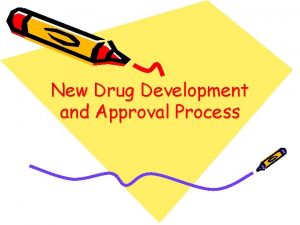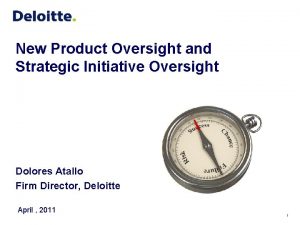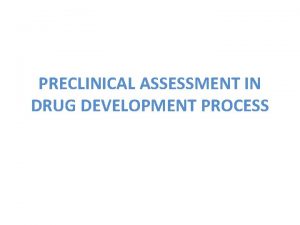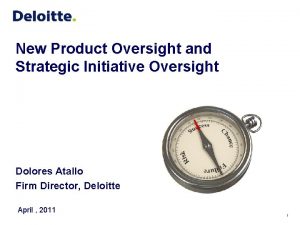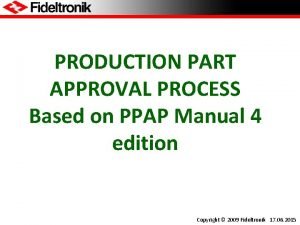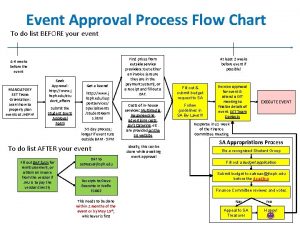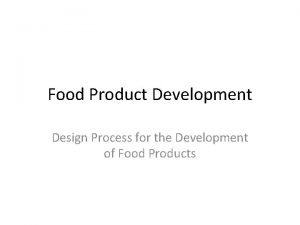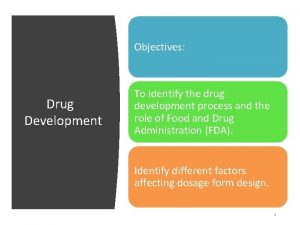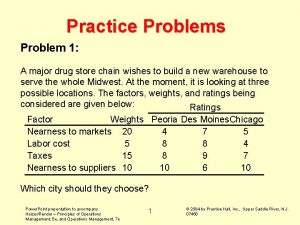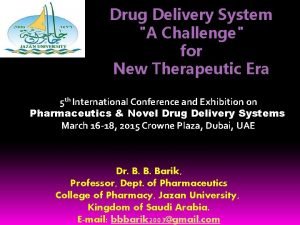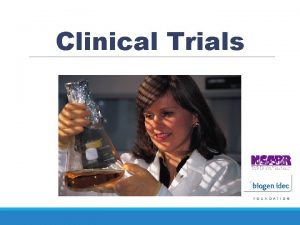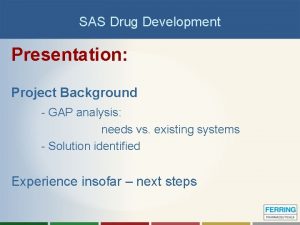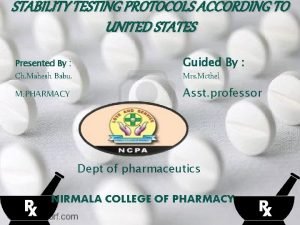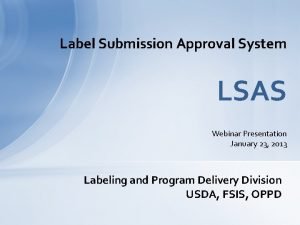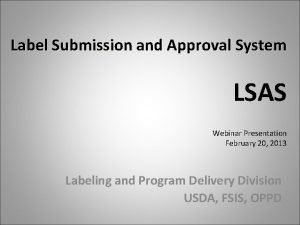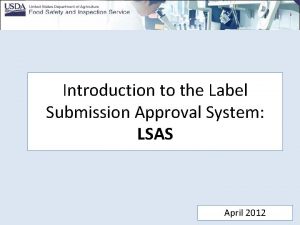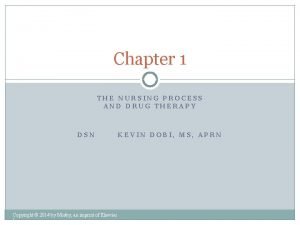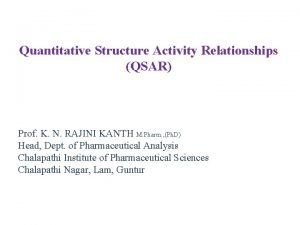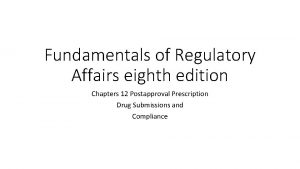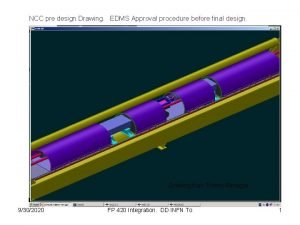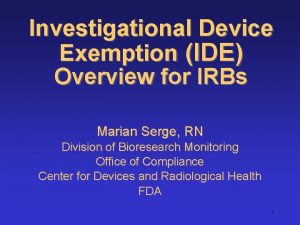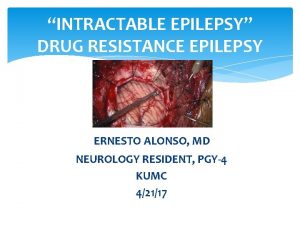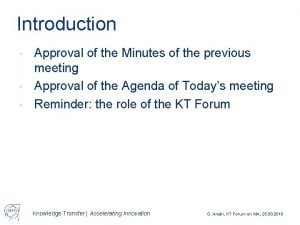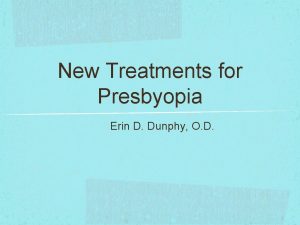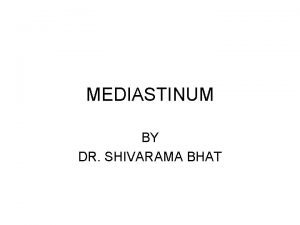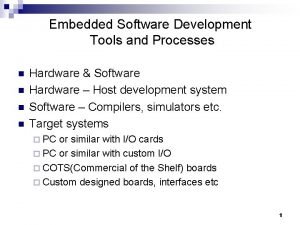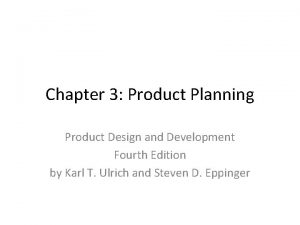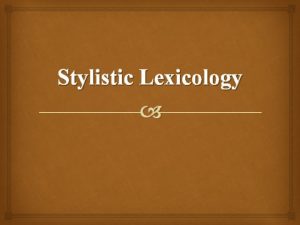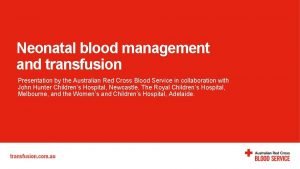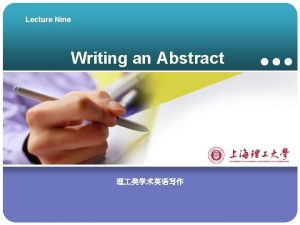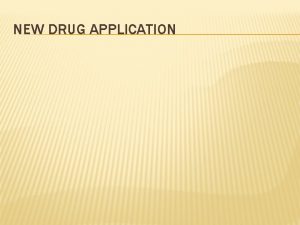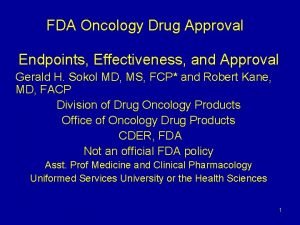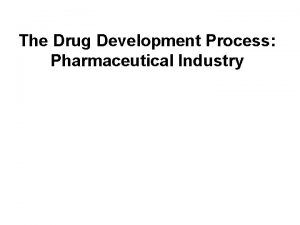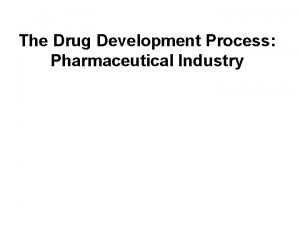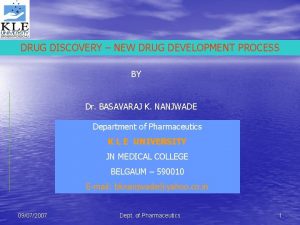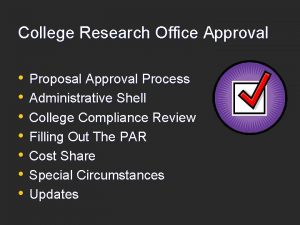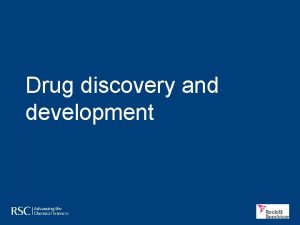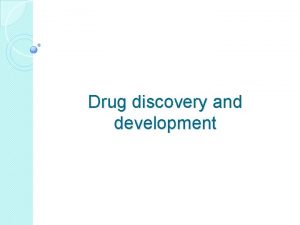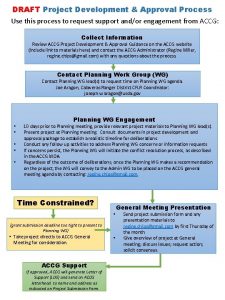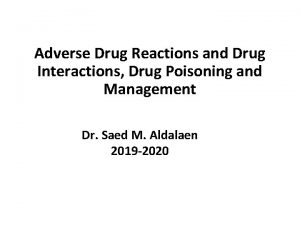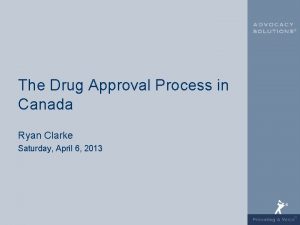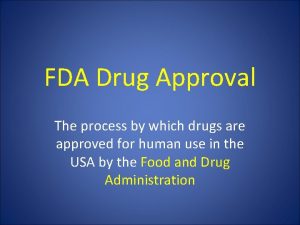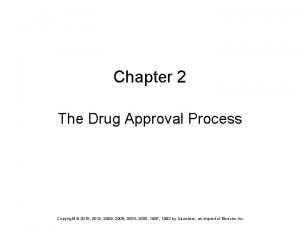New Drug Development and Approval Process Contents 1










































































































- Slides: 106

New Drug Development and Approval Process

Contents 1. 2. 3. 4. Drug discovery and drug design Biological characterization Early formulation studies The investigational New Drug (IND) Application(研究性新药申请) 5. The New Drug Application (NDA)

The Federal Food, Drug, and Cosmetic Act, as regulated through Title 21 of the U. S. Code of Federal Regulations, requires a new drug to be approved by the Food and Drug Administration(FDA) before it may be legally introduced in interstate commerce

To gain approval for marketing, a drug’s sponsor (e. g. , a pharmaceutical company) must demonstrate, through supporting scientific evidence, that the new drug or drug product is safe and effective for its proposed use. The sponsor must also demonstrate that the various processes and controls used in producing the drug substance and in manufacturing, packaging, and labeling are properly controlled and validated to ensure that the product meets established standards

The process and time course from drug discovery to approval for marketing can be divided into following process: New Chemical Entity (synthesis) Prefomulation studies-define the physical and chemical properties Formulation studies-develop the initial features of the proposed pharmaceutical product or dosage form Investigational new drug application(IND)-for initial testing in humans Preclinical and Clinical studies Phase I-initial testing in humans Phase II, Phase III -progressive human. Trials New drug application (NDA)-seeking approval to market the new product.

Content of a product’s approved labeling-essential chemistry, pharmacology, toxicology, indications and contraindication for use, adverse effects, formulation composition, dosage, and storage requirements. Treatment IND, Orphan drug Supplemental new drug application (SNDA) Abbreviated new drug application(简化新药申请) to gain approved to market a duplicate Antibiotic drug; biologics; Medical devices



1. Drug Discovery and Drug Design 1) 2) 3) 4) 5) Sources of new drugs A goal drug Methods of drug discovery A lead compound Prodrugs

1) Sources of new drugs • New drugs may be discovered from a variety of natural sources or synthesized in the laboratory. • Plant materials have served as a reservoir of potential new drugs.

• Reserpine (利血平), a tranquilizer (镇定剂) and hypotensive agent, from the folklore remedy Rauwolfia serpentina(萝芙木属蛇根碱). • Periwinkle( 长 春 花 ) , or Vinca rosea, in the treatment of diabetes mellitus.

• Vinblastine (长春碱) and vincristine ( 长 春 新 碱 ) , from Vinca rosea, exhibited antitumor capabilities. • Paclitaxel (Taxol), from an extract of the Pacific yew (紫杉)tree, is used in the treatment of ovarian cancer.

• After the isolation and structural identification of active plant constituents, organic chemists may recreate them by total synthesis in the laboratory. • The natural chemical could be also used as the starting material in the creation of slightly different chemical structures through molecular manipulation. The new structures, termed semisynthetic drugs.

• Animals have served humans in their search for drugs in a number of ways. • Hormonal substances, such as thyroid ( 甲状腺) extract, insulin, and pituitary (脑垂体)hormone obtained from the endocrine glands of cattle, sheep, and swine. • The use of animals in the production of various biologic products, including serums, antitoxins, and vaccines.

• New vaccines for diseases as AIDS and cancer are being developed through the use of cell and tissue cultures. • A new era in the development of pharmaceutical products comes forth as a result of the advent of genetic engineering, the manipulation of the double helix, the spiral DNA chain of life. (药物产品发展的新时代到来由于基因 程,生命DNA链的双螺旋操作的出现。)

• Through this process, will come more abundant and vastly purer antibiotics, vaccines, and yet unknown chemical and biological products to combat human disease. • 通过这些过程,将会出现丰富而大量的 更纯的抗生素、疫苗、还有其他未知的 化学和生物制品,以抵抗人类疾病。

There are two basic technologies that drive the genetic field of drug development • Recombinant DNA (r. DNA) • Monoclonal antibody (Mo. AB) production

2) A goal drug (目标药物) In theory, a “goal drug” • would produce the specifically desired effect, • be administered by the most desired route (generally orally) at minimal dosage and dosing frequency, • have optimal onset and duration of activity, 理论上,目标药物应能通过最理想的途径 (通常为口服)以最小的剂量和给药频率 给药,能产生特异的期望疗效,具有最理 想的起效和持续时间,

• exhibit no side effects, • following its desired effect would be eliminated from the body efficiently, completely, and without residual effect. • it would be easily produced at low cost, • be pharmaceutically elegant, • physically and chemically stable under various conditions of use and storage. (无副作用,并在发挥疗效后能完全有效地从体内消 除,且无残留效应。它应该易于生产,费用低,制 剂产品美观,在不同的使用和贮藏条件下物理和化 学上稳定。)

3) Methods of drug discovery • Most drugs are the result of carefully designed research programs of screening, molecular modification, and mechanismbased drug design. (大多数药物是精心设计的研究过程的结果,包 括:筛选、分子修饰和基于机制的药物设计。)

• To detect and evaluate biological activity, bioassays are used to differentiate the effect and potency of the test agent compared with controls of known action and effect. In vitro Cell culture In vivo Disease-specific Animal models

• New methods, as high throughput screening, are capable of examining 15000 chemical compounds a week using 10 -20 biological assays. • High-throughput screening (HTS) is a method for scientific experimentation especially used in drug discovery and relevant to the fields of biology and chemistry.

• To be effective, this requires a sizeable and chemically diverse collection of compounds to examine, which many pharmaceutical and chemical companies have in “chemical libraries. ” (为了有效地利用它,这需要有相当大量 的不同化学物质来测试,通常许多制药 公司或化学品公司有“化合物库”)

• Molecular modification involves the chemical alteration of a known and previously characterized organic compound for the purpose of enhancing its usefulness as a drug. (分子修饰涉及化学改变已知和特性明了 的有机化合物以改善其作为药物的有效 性。)

Aims for molecular modification • Enhancing its specificity for a particular body target site; • Increasing its potency; • Improving its rate and extent of absorption; • Modifying to advantage its time-course in the body; • Reducing its toxicity; • Changing its physical or chemical properties to provide pharmaceutically desired features;

How? Changes in • functional groups • Ring structures • Configuration (构型) (SAR)


• Mechanism-based drug design involves molecular modification in designing a drug that interferes specifically with the known or suspected biochemical pathway or mechanism of a disease process. (基于机制的药物设计包括通过分子修饰设 计药物,这种药物能够特异性地影响疾病 过程的已知或可能的生化途径或机制。)

The intention is the interaction of the drug with • specific cell receptors, • enzyme systems, • the metabolic processes of pathogens or tumor cells, resulting in a blocking, disruption, or reversal of the disease process. (设计的意图是影响药物与特异性受体、酶系统、 病原体或癌细胞的代谢途径的相互作用,导致 疾病过程的阻滞、破坏或逆转。)

Molecular graphics, the use of computer graphics to represent and manipulate the structure of the drug molecule to “fit” the simulated molecular structure of the receptor site. (利用计算机绘图来描绘和操纵药物分子的 结构使之“适合”于受体部位的分子设计是 药物分子设计的有用的和互补的 具。)

• Enalaprilat(依那普利拉,Vasotec)inhibits the angiotensin-converting enzyme • Ranitidine (Zantac)-an inhibitor of histamine at the H 2 -receptor • Sertraline (舍曲林, Zoloft)-inhibits the central nervous system neuronal uptake of serotonin(5 -羟色胺 )

4) A Lead Compound(先导化合物) • is a prototype( 原 形 化 学 物 质 ) chemical compound that has a fundamental desired biologic or pharmacologic activity. (先导化合物是一种具有生物学和药理学活 性基本要求的原型化学物质。)

• Although active, the lead compound may not posses all of the features desired; i. e. , potency( 效 力 ) , absorbability( 吸 收 性 ) , solubility, low toxicity, and so forth. • The medicinal chemist may seek to modify the lead compound’s chemical structure to achieve the desired features while reducing the undesired one.

• Finasteride (非那雄胺, Proscar) – benign prostatic hyperplasia • Propecia (a lower recommended dosage)-male pattern baldness.

5) Prodrugs • is a term used to describe a compound that requires metabolic biotransformation after administration to produce the desired pharmacologically active compound. (前体药物使之能够在给药后经体内代谢性 生物转化成具有期望的药理活性化合物的 化合物。)

• The conversion of an inactive prodrug to an active compound occurs primarily through enzymatic biochemical cleavage. • Prodrugs may be designed preferentially for the following reasons. • Solubility • Absorption • Biostability • Prolonged release

• FDA’s definition of a new drug • According to the FDA, a new drug is any that is not recognized as being safe and effective in the conditions recommended for its use among experts who are qualified by scientific training and experience. • A change in a previously approved drug product’s formulation or method of manufacture constitutes newness under the law • A combination of two or more old drugs or a change in usual proportions of drugs in an established ones • A proposed new use for an established drug, a new dosage schedule or regimen, a new route of administration, or a new dosage form all cause a drug or drug product’s status to new and triggers reconsideration for safety and efficacy

• Drug Nomenclature • 系统命名法

2. Biological characterization 1) Pharmacology 2) Drug metabolism 3) Toxicology

Prospective drug substances must undergo preclinical testing for biologic activity to assess their potential as useful therapeutic agents. pharmacology Drug metabolism toxicology

1) Pharmacology • embraces the physical and chemical properties, • biochemical and physiological effects • mechanisms of action, absorption, distribution, biotransformation, excretion, • useful applications of drugs.

• Pharmacodynamics is the study of the biochemical and physiological effects of drugs and their mechanisms of action. • Pharmacokinetics deals with the absorption, distribution, metabolism or biotransformation, and excretion of drugs.

• Clinical pharmacology applies pharmacologic principles to the study of the effects and actions of drugs in humans.

Most diseases arise from • a biochemical imbalance • An abnormal proliferation of cells • An endogenous deficiency • An exogenous chemical toxin • Invasive pathogen (病原体)

• Intricate enzymatic reactions • Structure-activity relationships (SAR) • Relationship between the quantity of drug molecules available for interaction and the capacity of the specific receptor site • Certain cells within the body are capable of binding drugs without eliciting a drug effect.

Cell culture Isolated animal tissues Whole animal studies Animal models of human disease

The primary objective of the animal studies is • to obtain basic information on the drug’s effects that may be used to predict safe and effective use in humans.

2) Drug Metabolism A series of animal studies of a proposed drug’s metabolism are undertaken to determine: • the rate, primary and secondary sites, and mechanism of the drug’s metabolism in the body, • the chemistry and pharmacology of any metabolites.

• Drugs that enter the hepatic(肝 脏 的 ) circulation after absorption from the gut, as after oral administration, are particularly exposed to rapid drug metabolism. • This transit through the liver and exposure to the hepatic enzyme system is termed the first-pass effect.

• Drug metabolism or biotransformation frequently results in the production of one or more metabolites of the administered drug, some of which may be pharmacologically active compounds. • When metabolites are found, they are chemically and biologically characterized for activity and toxicity.

3) Toxicology is the area of pharmacology that deals with the adverse, or undesired, effects of drugs. • In drug development programs, preclinical drug safety evaluation or toxicity studies are undertaken to determine: - The substance’s potential for toxicity with short-term (acute effects) or long-term use (chronic effects).

- the substance’s potential for specific organ toxicity, - the mode, site, and degree of toxicity, - dose-response relationships, for low-highand intermediate doses over a specified time course, - gender, reproductive, or teratogenic (产生 畸形的) toxicities, - the substance’s carcinogenic and genotoxic (遗传毒性的)potential.

① Acute or short-term toxicity studies These studies are designed to determine • the toxic effects of a test compound • when administered in a single dose and/or in multiple doses • over a short period, usually a single day.

• • • The test compound is administered at various dose levels, with toxic signs observed for onset (观察毒性反应的开始) progression or reversal (发展或逆转) severity (严重性) mortality (死亡率) rates of incidence (事件的发生率)

• • • The animals are observed and compared with controls for eating and drinking habits, weight change, toxic effects, psychomotor changes(精神变化), any other signs of untoward effects, usually over a 30 day postdose period.

② Subacute(亚急性) or subchronic(亚 慢性)studies • Animal toxicity studies of a minimum of 2 weeks duration of daily drug administration at three or more dosage levels to two animal species are required to support the initial administration of a single dose in human clinical testing. • These studies are termed subacute or subchronic.

Chronic toxicity studies, For drugs intended to be given to humans for a week or more, animal studies of 90 to 180 days in length must demonstrate safety.

③ Carcinogenicity studies (致癌性研究) Carcinogenicity testing is usually a component of chronic testing,is undertaken when the compound has shown sufficient promise as a drug to enter human clinical trials.

• Carcinogenicity studies are usually carried out in a limited number of rat and mouse strains for which there is reasonable information on spontaneous tumor incidence(自发性 肿瘤形成).

④ Reproduction studies (生殖研究) • These studies are undertaken to reveal any effect of an active ingredient on mammalian reproduction. Included in these studies are • fertility and mating behavior (抚养和交配行 为) • Early embryonic and pre- and post-natal development (胚胎早期、早产和产后发育) • Multigenerational effects (多代影响) • Teratology (致畸性)

3. Early formulation studies 1) Preformulation studies 2) Initial product formulation and clinical trial materials

Physical chemical properties from initial to final formulation Clinical trials from pilot plant to scale-up large scale manufacturing

1) Preformulation studies (处方前研究) Each drug substance has intrinsic (固有的) chemical and physical characteristics that must be considered before the development of a pharmaceutical formulation

① Drug solubility • A drug substance administered by any route must possess some aqueous solubility for systemic absorption and therapeutic response. • Poorly soluble compounds (less than 10 mg/ml) may exhibit either incomplete or erratic(不稳定) absorption and thus produce a minimal response at desired dosage.

Enhanced aqueous solubility may be achieved by • preparing more soluble derivatives of the parent compound, such as salts or esters; • by chemical complexation; • by reducing the drug’s particle size.

② Partition coefficient To produce a pharmacologic response, a drug molecule must first cross a biologic membrane of protein and lipid, which acts as a lipophilic barrier to many drugs.

A drug’s partition coefficient is • a measure of its distribution in a lipophilic/hydrophilic phase system, • indicative of its ability to penetrate biologic multiphase systems.


③ Dissolution rate • The rate at which a drug substance dissolves in a medium is called its dissolution rate. • Dissolution rate data, when considered along with data on a drug’s solubility, dissolution constant, and partition coefficient, can provide an indication of the drug’s absorption potential following administration.

• For a chemical entity, its acid, base, or salt forms, as well as its physical form (e. g. particle size), may result in substantial differences in the dissolution rate.

④ Physical form The crystal or amorphous forms and particle size of a powdered drug can affect the dissolution rate, and thus the rate and extent of absorption, for a number of drugs.

⑤ Stability The chemical and physical stability of a drug substance alone, and when combined with formulation components, is critical in preparing a successful pharmaceutical product.

2) initial product formulation and clinical trial materials An initial product is formulated - using the information gained during the preformulation studies - with consideration of the doses, dosage form, route of administration desired for the clinical studies and for the proposed marketed product.

• For phase 1 studies, orally administered drugs, capsules are employed containing the active ingredient alone, without pharmaceutical excipients. • Excipients are included in the formulation for Phase 2 trials. • Different formulations may be prepared and examined to develop the one having the desired characteristics. • During phase 2, the final dosage form is selected and developed for Phase 3 trials.




• The Investigational New Drug (IND) Application • Under the Food, Drug, and Cosmetic Act as amended, the sponsor of a new drug is required to file with the FDA an IND before the drug may be given to human subjects. • This is to protect the rights and safety of the subjects and to ensure that the investigational plan is sound and is designed to achieve the stated objectives • After submission of the IND, the sponsor must delay use of the drug in human subjects for not less than 30 days from the date the FDA acknowledge receipt of the application.

• • (1) Content of the IND (2) The Clinical Protocol (3) Pre-IND Meetings On request, the FDA will advise a sponsor on scientific, technical, or formatting concerns relating to the preparation and submission of an IND • (4) FDA Review of an IND Application • The FDA’s objectives in reviewing an IND are to protect the safety and rights of the human subjects and to help ensure that the study allows the evaluation of the drug’s safety and effectiveness.

• (5) FDA Drug Classification system • Upon receipt and examination of an IND or NDA, the FDA classifies the drug by chemical type and therapeutic potential. Page 49 • (6) Phases of a Clinical Investigation • An IND may be submitted for one or more phases of a clinical investigation, namely Phase 1, Phase 2, or Phase 3 • Phase 1 includes the initial introduction of an investigational drug into humans and is primarily for the purpose of assessing safety. • Phase 1 studies are designed to determine the human pharmacology of the drug, structureactivity relationship, side effects associated with increasing doses, and if possible, early evidence of effectiveness.

• Phase 2 trials are controlled clinical studies to evaluate the effectiveness of a drug in patients with the condition for which the drug is intended and to assess side effects and risks that may be revealed. Because this phase uses patients as subjects, side effects or toxicity symptoms that were not shown in the preclinical animal studies or in Phase 1 studies with healthy volunteers may be revealed for the first time. • Phase 3 studies may include several hundred to several thousand patients in controlled and uncontrolled trials. The objective is to determine the usefulness of the drug in an expanded patient base.

• (7) Clinical Study Controls and Designs • Phase 2 and some Phase 3 studies are controlled, that is, the effects of the investigational drug are compared with another agent. The second agent may be a placebo (placebo control) or an active drug (positive control), a standard or comparator drug product. • For studies that are blinded, the identities of the investigational drug and the control and controls are not revealed to certain participants to decrease bias • In designing a clinical trial, many addition factors are considered, including the scheme of the study design and the duration of the treatment

• (8) Drug dosage and Terminology • A major part of any clinical drug is the determination of a drug’s safe and effective dose. Dose and dose ranging studies are conducted during Phase 2 and concluded during Phase 3 clinical trials. • The safe and effective dose of a drug depends on a number of factors, including characteristics of the drug substances, the dosage form and its route of administration, and a variety of patient factors including age, body weight, general health status, any pathologic conditions, and concomitant drug therapy. All of these factors and others are integral to clinical drug trials

• • • The dose of a drug may be described as an amount that is enough but not too much; the idea is to achieve the drug’s optimum therapeutic effect with safety but at the lowest possible dose The effective dose of a drug may be different for different patients. Usual adult dose; usual dosage range; usual pediatric dose The schedule of dosage, or the dosage regimen, is determined during the clinical investigation and is based largely on a drug’s inherent duration of action, its pharmacokinetics, and the characteristics of the dosage form. Initial dose; priming dose; loading dose; Prophylactic dose (预防剂量); therapeutic dose

To provide systemic effects, a drug must be absorbed from its routs of administration at a suitable rate, be distributed in adequate concentration to receptor sites, and remain there for a sufficient period. Minimum effective concentration (MEC); Minimum toxic concentration (MTC); Median effective dose; therapeutic index Some factors of patients considered in determining a drug’s dose in clinical investigations and in medical practice include the following: Age, Body weight, Body Surface Area, Sex, Pathologic state, Torlerance, Concomitant Drug Therapy, Time and Conditions of Administration, Dosage Form and Route of Administration

• (9)Treatment IND • A treatment IND or a treatment protocol permits the use of an investigational drug in the trentment of patients not enrolled in the clinical study but who have a serious or immediately life-threatening disease for which there is non satisfactory alternative therapy. • (10) IND for an Orphan Drug • (11) Withdrawal or Termination of an IND • The New Drug Application • If the three phases of clinical testing during the IND period demonstrate sufficient drug safety and therapeutic effectiveness, the sponsor may file a NDA with the FDA. This filing may be proceded by a pre-NDA meeting between the sponsor and the FDA to discuss the content and format of the new drug application.

• The purpose of the NDA is to gain permission to market the drug product in the United states. • (1) General Content of the NDA Submission • • • (2) Drug Product Labeling (a) Description of product (b)Clinical pharmacology; (c) Indications and usage (d) Contraindications (e) Warnings (f) Precautions (g) Adverse reactions (h) drug abuse and dependence (i) Overdosage (j) Dosage and administration (k) How supplied

• FDA Review and Action Letters • The completed NDA is carefully reviewed by the FDA, which decides whether to allow the sponsor to market the drug, to disallow marketing, or to require additional data before rendering a judgement. • Phase 4 stuidies and Postmarketing Surveillance • The receipt of marketing status for a new drug product does not necessarily end a sponsor’s investigation of the drug. Continued clinical investigations, often called Phase 4 studies. • Annual Reports

• Supplemental, Abbreviated, and Other applications • Supplemental New Drug Application • A sponsor of an approved NDA may make changes in that application through the filing of a supplemental new drug application (SNDA) • Abbreviated New Drug Application • An abbreviated new drug application (ANDA) is one in which nonclinical laboratory studies and clinical investigations may be omitted, except those pertaining to the drug’s bioavailablility • Biologics License Application

• Animal Drug Applications • Medical Devices • International Conference on Harmonization of Technical Requirements for Registration of Pharmaceuticals for Human Use

Questions 1. Describe the methods of drug discovery 2. Define the following phrases: - prodrugs - a lead compound - a goal drug 3. What physical and chemical properties of drug substances must be characterized during preformulation studies? Explain. 4. What biological characterization should be studied in drug development process ?















 Abbreviated new drug application
Abbreviated new drug application Mexterial
Mexterial Preclinical stage
Preclinical stage An example of crude drug adulterated with exhausted drug
An example of crude drug adulterated with exhausted drug New product initiative
New product initiative Project approval system
Project approval system Capex approval
Capex approval Ppap documents
Ppap documents Event process flow
Event process flow Product planning and development definition
Product planning and development definition Career opportunities in biotechnology and drug development
Career opportunities in biotechnology and drug development New product development of cadbury
New product development of cadbury Stages of food product development
Stages of food product development New service development in service marketing
New service development in service marketing Abbreviated new drug application
Abbreviated new drug application Brave new world castes
Brave new world castes Brave new world caste system
Brave new world caste system A major drug store chain wishes to build a new warehouse
A major drug store chain wishes to build a new warehouse Challenges of novel drug delivery system
Challenges of novel drug delivery system Clinical trial timeline
Clinical trial timeline Sas drug development
Sas drug development Post-approval stability protocol and stability commitment
Post-approval stability protocol and stability commitment Neurotic need for prestige
Neurotic need for prestige Label submission and approval system (lsas)
Label submission and approval system (lsas) Lsas usda
Lsas usda Label submission and approval system (lsas)
Label submission and approval system (lsas) Nursing process in drug therapy
Nursing process in drug therapy Qsar notes
Qsar notes Ppap samples
Ppap samples Usaa preapproval
Usaa preapproval Travel request approval workflow
Travel request approval workflow Project approval lifecycle (pal framework)
Project approval lifecycle (pal framework) What is srea
What is srea Zetadocs express
Zetadocs express Post approval stability protocol
Post approval stability protocol Invoice approval email
Invoice approval email E-approval system
E-approval system Appetite approval ambition
Appetite approval ambition Ceo approval
Ceo approval Gef project cycle
Gef project cycle Jppap
Jppap Post approval regulatory affairs
Post approval regulatory affairs Ung dual enrollment deadline
Ung dual enrollment deadline Pbn approval
Pbn approval Conflict of commitment
Conflict of commitment Cte tac
Cte tac Expression of approval
Expression of approval Drawing approval procedure
Drawing approval procedure Credit approval authority
Credit approval authority Fda approval means nothing
Fda approval means nothing Fda approval means nothing
Fda approval means nothing Bhuvan isro pmay
Bhuvan isro pmay Faa 337 address
Faa 337 address Cdbm approval
Cdbm approval Approval sheet
Approval sheet Rfa request for approval
Rfa request for approval Mandiri cash management user still login
Mandiri cash management user still login Coscap np
Coscap np Approval of previous minutes
Approval of previous minutes Paf approval
Paf approval Divine approval for a chinese ruler
Divine approval for a chinese ruler Fov tears
Fov tears Udel concur
Udel concur Cause and effect contents of the dead man's pocket
Cause and effect contents of the dead man's pocket Sinus of pericardium
Sinus of pericardium Outlining and organizing the speech contents
Outlining and organizing the speech contents Elagse
Elagse New york pennsylvania new jersey delaware
New york pennsylvania new jersey delaware Fresh oil new wine
Fresh oil new wine Strengths and weaknesses of the articles of confederation
Strengths and weaknesses of the articles of confederation What forces are defining the new marketing realities
What forces are defining the new marketing realities New classical and new keynesian macroeconomics
New classical and new keynesian macroeconomics Chapter 16 toward a new heaven and a new earth
Chapter 16 toward a new heaven and a new earth Both new hampshire and new york desire more territory
Both new hampshire and new york desire more territory New classical and new keynesian macroeconomics
New classical and new keynesian macroeconomics New product development and product life cycle strategies
New product development and product life cycle strategies Microsoft new england research and development center
Microsoft new england research and development center Nyc youth and community development
Nyc youth and community development Product planning and development
Product planning and development Faculty model of training
Faculty model of training Embedded system software development tools
Embedded system software development tools Textbook design and development procedure
Textbook design and development procedure The database environment and development process
The database environment and development process Product platform planning examples
Product platform planning examples The database environment and development process
The database environment and development process What does a career portfolio look like
What does a career portfolio look like Deep perineal pouch contents
Deep perineal pouch contents Trali symptoms
Trali symptoms Fresh frozen plasma vs platelets
Fresh frozen plasma vs platelets Middle mediastinum: contents mnemonic
Middle mediastinum: contents mnemonic Branches of common femoral artery
Branches of common femoral artery Middle mediastinum: contents mnemonic
Middle mediastinum: contents mnemonic The immortal life of henrietta lacks table of contents
The immortal life of henrietta lacks table of contents Medial lemniscus
Medial lemniscus Subscapular artery anastomosis
Subscapular artery anastomosis Contents of the ark of the covenant
Contents of the ark of the covenant So we meet again my dear doctor
So we meet again my dear doctor Omental appendices
Omental appendices Mla table of contents
Mla table of contents Contents of stylistic lexis
Contents of stylistic lexis How to make school magazine cover page
How to make school magazine cover page Examples of continuous variables
Examples of continuous variables Appendices in report
Appendices in report Platelets transfusion indication
Platelets transfusion indication Mediastinum subdivision
Mediastinum subdivision Pericardium mediastinum
Pericardium mediastinum Abstract or introduction
Abstract or introduction
